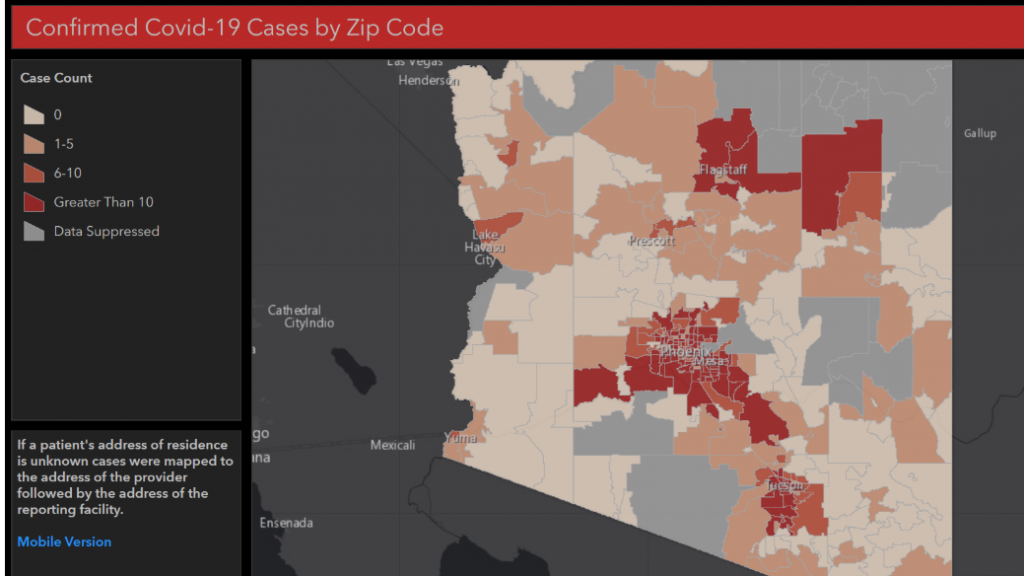 Today we added data to our COVID-19 dashboard that includes additional information about cases and deaths, as well as information about the health of our healthcare system in Arizona. The dashboard now has case counts broken down by zip code and more detailed demographic information about cases and deaths in our state. Data about the capacity of our healthcare system in Arizona has also been added to the dashboard.
Today we added data to our COVID-19 dashboard that includes additional information about cases and deaths, as well as information about the health of our healthcare system in Arizona. The dashboard now has case counts broken down by zip code and more detailed demographic information about cases and deaths in our state. Data about the capacity of our healthcare system in Arizona has also been added to the dashboard.
COVID-19 Case Data
Dashboard updates include tabs that show the demographic breakdown of cases including age, gender, and race or ethnicity, if known. A tab added to the dashboard today shows case counts by zip code, including the ability to search for information within a specific zip code. Of note, zip codes where there are between one and ten COVID-19 positive individuals who have been identified, the dashboard will show a numerical range, either 1-5 or 6-10, rather than an exact case count. This is to preserve anonymity within the data and protect the private health information of these patients. An additional tab on our dashboard has been added to better categorize fatalities associated with COVID-19, including age and gender. The data aligns with what has been seen in other jurisdictions, with a higher proportion of COVID-19 associated deaths in Arizona occurring in individuals over the age of 65.
A critical note about all of the case data presented is that it only reflects individuals who have tested positive for COVID-19. While public health and healthcare institutions continue to work to increase testing availability, the persistent limitations in supplies mean that not everyone who wants to be tested can be. In addition, we know that people can be infected and spread disease without showing symptoms. While physical distancing is occurring, people do not always remain isolated within their own zip code when conducting essential business. Finally, zip code counts include anyone in that zip code who has tested positive, whether their infection occurred two months ago and has resolved or two weeks ago and is still active. Thus, while zip code data is informative, it should not be used to determine whether or not residents of a particular zip code are or are not at risk of COVID-19.
Syndromic data is an additional indicator public health uses to understand the burden of more severe disease in a population.. When individuals visit an emergency room or are admitted to the hospital, the hospital record has documentation of their symptoms. Through syndromic surveillance, public health can get a picture of the percent of emergency room visits or inpatient admissions where a patient has a particular collection of symptoms. We use this information every year as a component of our influenza surveillance. To estimate how persistent hospital COVID-19-like-illness is in our community, we have been tracking whether the percentage of people at the hospital presenting with symptoms of COVID-19 is increasing or decreasing. This is displayed in the fifth tab on our main dashboard now as well. Scroll to the right to see that final tab.
Healthcare System Data
Multiple enhanced surveillance advisories ordered by Governor Ducey allow public health to better track the health of the healthcare system in Arizona. This includes data about the capacity and current utilization of emergency room beds, inpatient beds, ICU beds, and ventilators in hospitals throughout Arizona. This is data we are monitoring closely as it shows us where we need to focus our efforts to increase capacity. The information is now posted on our dashboard and demonstrates that right now, there is capacity within our healthcare system to handle an increase in COVID-19 hospitalizations.
Preparing our healthcare system for a potential surge in cases is a top public health priority because we have community spread COVID-19 in all 15 counties in Arizona and we are expecting additional cases and deaths. To bolster Arizona’s preparedness to handle a potential surge in cases beyond current healthcare system capacity, Governor Ducey issued executive orders requiring hospitals to increase their overall high acuity capacity by 50 percent and to postpone elective surgeries so that critical resources, such as personal protective equipment (PPE) and ventilators, can be conserved for the COVID response. We are also standing up alternate care sites around the state. This includes reopening St. Luke’s hospital in Phoenix and working with the U.S. Army Corps of Engineers to assess locations for potential alternate care sites in Flagstaff, and Tucson, and Maricopa County.
While the healthcare system data shows capacity for an increase in hospitalizations, public health is closely monitoring the extreme healthcare surge in other parts of the country and the world. The steps we are taking are intended to prepare Arizona to rapidly react to a surge in hospitalizations that could overwhelm our healthcare system in its current state. We will continue to share additional data and are working on building out more data points, including information regarding outbreaks, PPE, and outcomes.
We urge everyone to remain vigilant and follow Governor Ducey’s “Stay Home. Stay Healthy. Stay Connected” order. Continuing to physically distance while also taking recommended prevention measures — wash your hands, avoid touching your face, stay home if you are unwell, consider wearing a cloth face covering when you cannot appropriately physically distance — will keep Arizona headed in the right direction. We all need to do our part to slow the spread of COVID-19 in our communities. For the latest information about the Arizona response to COVID-19, please visit our website.









